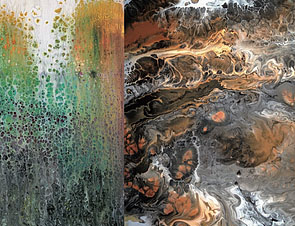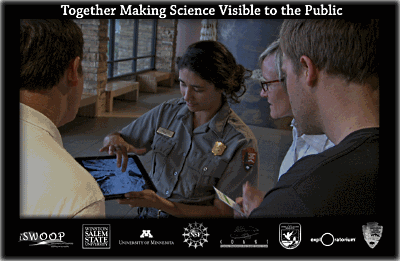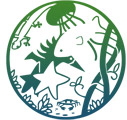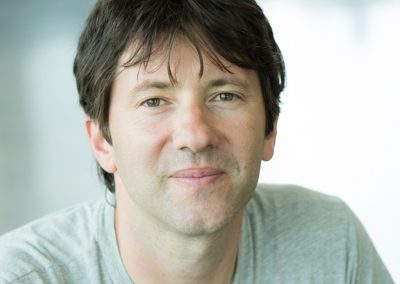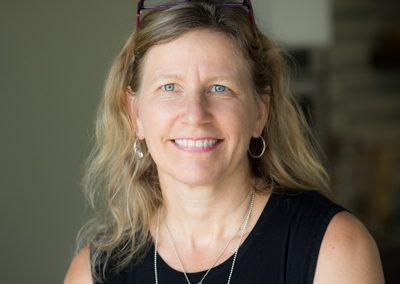Integrative Biology
Integrative and Comparative Biology Symposium
Frequent CDI Collaborators from WSSU, UNCSA, UNC, TERC, U-Minn, and USFWS build new connections and create new work
Science in the Public Eye: Leveraging Partnerships
January 4th 2018, representatives from CDI: Betsy Towns, Nick Hristov, and Louise Allen, as well as collaborators Katherine Gil (Tributary Land Design), Martha Merson (TERC), Shauna Marquardt (USFWS) and Carol Strohecker (University of Minnesota) gathered to discuss current projects, future endeavors & areas of potential collaboration, and to finalize their January 6th symposium, part of Society for Integrative and Comparative Biology 2018 Annual Meeting. The symposium, “Science in the Public Eye: Leveraging Partnerships” was sponsored by iSWOOP/TERC/NSF.
Together with Martha Merson of TERC, the symposium’s founders brought together fellow scientists, project collaborators: artists, educators and researchers from governmental organizations to discuss topics not often found at biology conferences. Topics included effective ways of communicating science to the public, the design process for sites of STEM learning, citizen science, and developing visualizations that enhance science understanding.
Four Publications
CDI-Authored Articles in Oxford’s Journal of Integrative Biology
Martha Merson, Louise C. Allen and Nickolay I. Hristov, “Science in thePublic Eye:Leveraging Partnerships-An Introduction”
Louise Allen, Cynthia Char, Nickolay Hristov, Tracey Wright and Martha Merson, “Beyond the Brown Bag: Designing Effective Professional Development for Informal Educators“
Nickolay Hristov, Carol Strohecker, Louise Allen and Martha Merson, “Designing for Broad Understanding of Insights from Practice”
Katherine Gill, Jocelyn Glazier and Betsy Towns, “Cultivating Collaboration Site Specific Design for Embodied Science Learning“
Science in the Public Eye: Leveraging Partnerships—An Introduction
Abstract
Beyond the Brown Bag: Designing Effective Professional Development for Informal Educators:
Abstract
Cultivating Collaborations: Abstract
Immersion in well-designed outdoor environments can foster the habits of mind that enable critical and authentic scientific questions to take root in students’ minds. Here we share two design cases in which careful, collaborative, and intentional design of outdoor learning environments for informal inquiry provide people of all ages with embodied opportunities to learn about the natural world, developing the capacity for understanding ecology and the ability to empathize, problem-solve, and reflect. Embodied learning, as facilitated by and in well-designed outdoor learning environments, leads students to develop new ways of seeing, new scientific questions, new ways to connect with ideas, with others, and new ways of thinking about the natural world. Using examples from our collaborative practises as experiential learning designers, we illustrate how creating the habits of mind critical to creating scientists, science-interested, and science-aware individuals benefits from providing students spaces to engage in embodied learning in nature. We show how public landscapes designed in creative partnerships between educators, scientists, designers, and the public have potential to amplify science learning for all.
A smaller group of the UNCSA students met again during the spring semester. We honed down the ideas that we generated as a group during intensive arts, and composed a more concise message to communicate to the audience and discussed how we wanted to convey this message. Do we want to make the audience feel guilty about the negative impact we have on the climate? Do we want to make them hopeful, motivated, angry? We realized that in order to convey a message that would make a worthwhile impact, we would have to represent each type of person and their relationship with the environment. Someone who takes from the environment, someone who gives to the environment, and someone in between.
Design for Broad Understanding of Science: Abstract
I believe that in the end our project was able to show how hard it is to piece our climate back together if the deterioration is outweighing the improvement. With the perfect music-dance pairing, eye-opening videos of the environment, the mounds of dirt supplied to help the dancers convey the human-environment relationships), and elemental lighting, we presented a powerful message. A message that declares, “yes”, the climate is changing, it is our fault, we have the capability to lessen our impact, so what do we do now? Are you going to leave a gentle handprint on the world, or just a pile of crinkled up soda cans?






